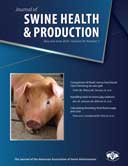Abstract:

Comparison of blunt versus functional claw trimming effects on sow gait
Amanda K. Tinkle, PhD; Mark E. Wilson, PhD; Jerry L. Torrison, DVM, PhD; Michael A. Parsley; Kylee J. Duberstein, PhD; Michael J. Azain, PhD; C. Robert Dove, PhD
Complete article is available online.
PDF version is available online.
Objective: To determine the effect of functional claw trimming versus blunt claw trimming on the gait of sows.
Materials and methods: Nineteen sows (PIC C29) were transported to the research center and claws were trimmed 3 times over an 8-day period. Dewclaws were trimmed even with the coronary band of the hoof on day 1. Claws were blunt trimmed on day 4 and functional trimming occurred on day 8. The gait of each sow was recorded prior to each trimming to compare the effect of the previous trimming. A final gait recording was taken on day 12. The gait data collected from the sows was compared across days to determine if any changes occurred.
Results: Positive improvements in gait data were noted after dewclaw trimming. Changes were seen in velocity (P = .03), stride length (P = .02), stride duration (P = .04), stance (P = .04), and rear percent stance (P = .03). Blunt trimming offset the improvement gained by trimming dewclaws, seen in the changes to rear percent stance (P = .02) and front swing (P = .04). Functional trimming increased the improvement observed by trimming dewclaws. Changes were seen in the stance (P < .001), percent stance (P < .001), stride duration (P = .003), stride length (P = .008), and velocity (P = .003).
Implications: Trimming dewclaws and functionally trimming claws improved the sow’s gait. Blunt trimming did not provide the same benefits observed by trimming dewclaws or functionally trimming the claws.
Keywords: gait analysis, claw trimming, blunt trimming, functional trimming
![]() Cite as: Tinkle AK, Wilson ME, Torrison JL, Parsley MA, Duberstein KJ, Azain MJ, Dove CR. Comparison of blunt versus functional claw trimming effects on sow gait. J Swine Health Prod 2020;28(3):118-123.
Cite as: Tinkle AK, Wilson ME, Torrison JL, Parsley MA, Duberstein KJ, Azain MJ, Dove CR. Comparison of blunt versus functional claw trimming effects on sow gait. J Swine Health Prod 2020;28(3):118-123.
Search the AASV web site for pages with similar keywords.
